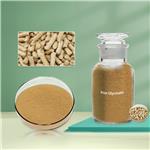Iron can be supplemented orally using various chemical formulations. Among them, the one based on the ferrous glycine sulfate (known as ferroglycine sulfate complex; FeGS) is very favourable due to a reduced presence of gastrointestinal side effects compared to standard preparations based on iron fumarate. FeGS is a FeII complex with the amino acid glycine. The 1:2 metal-to-ligand ratio restricts reaction with dietary inhibitors of iron absorption, neutralizes the valence of the ferrous FeII, and protects gastrointestinal surfaces from irritation by metal cations. Therefore, this structure makes FeGS an ideal fortifier, especially for foods with a high content of absorption inhibitors such as phytate[1].
Iron(II) gluconate (a ferrous gluconate) is used to treat hypochromic anemia. The real problem of iron therapy is not the theoretical utilization of iron, the reticulocyte response, or even the daily increase of hemoglobin. These are important only as they indicate the return of the patients' blood to normal in a reasonably short time without undue inconvenience. Most patients suffering from hypochromic anemia respond well to most forms of iron when administered in adequate dosage. For patients who cannot tolerate the usual iron compounds, it is essential to have a medication that is effective and causes minimum disturbance. Ferrous gluconate is such a medicament.
10.0 g of ferrous sulfate and 2.7 g of glycine are thoroughly mixed and
carefully heated under nitrogen to 70°C. Reaction occurs rapidly, and the
complex compound is obtained as soon as the color turns uniformly lightbrown.
After cooling to 20°C, 12.7 g of ferrous sulfate-glycine complex are
obtained, which contains 100 mg Fe++-ion sper 0.63 g.
Flammability and Explosibility
Not classified
structure and hydrogen bonding
The coordination polyhedron around the metal atom can be considered a strongly distorted octahedron with elongated axial edges. Figure 2 and Table 1 give the details of the coordination sphere around the metal cation. The equatorial oxygen atoms are separated from the metal centre at distances expected for a crystal structure of this kind [FeII–O bond lengths of 2.15(1) ?, 2.11(1) ?, 2.12(1) ? and 2.15(1) ?], where the axial oxygen atoms are found at unusually long distances [2.39(1) ? and 2.37(1) ?]. These lengths indicate very weak bonding, and it can be argued whether FeII–O contacts of ca. 2.4 ? are considered a classical chemical bond. Therefore, the coordination sphere around the FeII cation can even be considered square-planar.
![hydrogen (glycinato-N,O)[sulphato(2-)-O,O']ferrate(1-) hydrogen (glycinato-N,O)[sulphato(2-)-O,O']ferrate(1-)](/NewsImg/2024-06-11/6385369401487353212031090.png)
[1] R. Dinnebier, B. Hinrichsen, T. Run?evski. “Crystal Structure of the Dietary Supplement Ferrous Glycine Sulfate.” Zeitschrift für anorganische und allgemeine Chemie 37 3 1 (2016): 306–310.

![hydrogen (glycinato-N,O)[sulphato(2-)-O,O']ferrate(1-) hydrogen (glycinato-N,O)[sulphato(2-)-O,O']ferrate(1-)](/NewsImg/2024-06-11/6385369401487353212031090.png)

